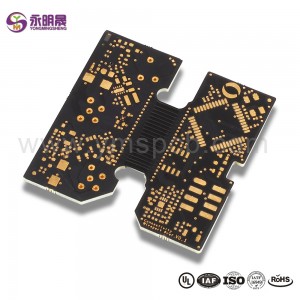HDI Flex-Rigid Board | YMS PCB
Rigid-Flex PCB’s advantages
Portability: in complex designs where small sizes are needed to control complexity, rigid-flexible PCB is an option because two substrates provide space for bending and orienting, in which small sizes are achieved to fit the design.
Cost reduction: for large PCB boards of other PCB types, it is possible to concentrate two or more boards on a single, lightweight board, eliminating the connector that is said to exist on a single board, thus greatly reducing the cost.
Easy to test: rigid – flexible PCB is very easy to test.Therefore, they are very suitable for use as prototype PCB.
Sturdiness: with the development of rigid and flexible PCB, PCB can withstand the harsh environment such as high temperature, high signal generation, high electron magnetic transfer, etc.All this is done by using flexible substrates.Polyimide.
Quality: the use of laminating ensures the highest quality.
General capabilities for polyimide rigid-flex circuit boards:
| Description | Leading-Edge Capabilities |
| Lines/spaces | 50/50 µm |
| Microvias/pads diameter (flex) | 40/100 µm |
| Microvias/pads diameter (rigid, laser) | 50/150 µm |
| Thinnest dielectric thickness (flex) | 25 µm |
| Thinnest dielectric thickness (rigid) | 50 µm |
| Conductor width tolerance | +/- 10% |
| Artwork to soldermask tolerance | +/- 15 µm |
| Layer count | up to 50 |








